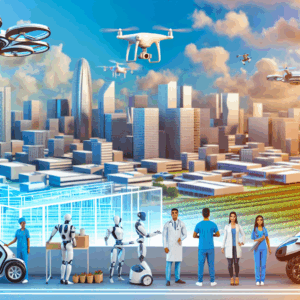Understanding Agent 2 Agent Communication in AI Systems
Introduction
In the dynamic and ever-expanding field of artificial intelligence (AI), agent communication emerges as a pivotal component of developing intelligent systems that can autonomously interact and perform tasks. The paradigm of agent-to-agent (A2A) communication underlines the method by which distinct agents—software programs carrying out specific tasks—exchange information, coordinate, and even negotiate to accomplish their objectives. As AI systems become more complex and distributed, A2A communication is increasingly essential, playing a significant role in enabling these systems to operate collaboratively and efficiently. This blog post delves into the fundamentals of A2A communication, its importance, real-world applications, current technologies, and future prospects.
Definition of Agent 2 Agent
In the context of AI, an agent is a software entity that perceives its environment through sensors and acts upon that environment through actuators to achieve specific goals. Agent 2 Agent (A2A) communication refers to the interaction between these agents, allowing them to exchange information, coordinate tasks, and undertake negotiations in a multi-agent system. Key characteristics of A2A interactions include message passing, collaborative behaviors, and protocol adherence to ensure consistent and effective communication.
Significance of Agent 2 Agent Communication
Agent 2 Agent communication plays a crucial role in the design of distributed systems and multi-agent systems, where multiple autonomous agents operate independently to solve problems collaboratively. By enabling agents to communicate, A2A systems facilitate improved decision-making and coordination, enhancing overall system efficiency. This mode of communication is pivotal for leveraging AI capabilities effectively, as it allows agents to share information, divide tasks, and optimize resource utilization. In real-world scenarios, robust A2A methods can lead to significant advancements in domains ranging from smart automation to autonomous vehicles and beyond.
Typical Use Cases of Agent 2 Agent
-
Smart Home Systems: In Internet of Things (IoT) ecosystems, A2A communication enables multiple devices, such as lighting, security cameras, and thermostats, to interact seamlessly. This coordination optimizes energy consumption and enhances user experiences by predicting and automating household tasks.
-
Autonomous Vehicle Coordination: Vehicles equipped with AI agents use A2A communication to negotiate and share data about road conditions, traffic patterns, and navigation routes. This collaborative approach enhances safety, efficiency, and overall traffic management.
-
Robotic Systems: In multi-robot environments, such as manufacturing or exploration scenarios, robots employ A2A communication for task delegation and collaboration. This ensures a division of labor and maximal efficiency in task completion.
Current Technologies and Frameworks
Agent 2 Agent communication is supported by a host of technologies and frameworks designed to streamline the development and deployment of multi-agent systems. Notable frameworks include:
-
JADE (Java Agent DEvelopment Framework): A widely used framework that enables the implementation of peer-to-peer agent-based applications in compliance with FIPA (Foundation for Intelligent Physical Agents) standards.
-
ROS (Robot Operating System): Provides a robust platform for developing multi-robot systems where communication is critical for task coordination and execution.
-
Protocols: FIPA’s Agent Communication Language (ACL) and MQTT are commonly used to define message syntax, semantics, and protocols for consistent and efficient agent interactions.
Programming languages such as Python and Java are extensively utilized in developing these systems due to their robust libraries and community support for AI and multi-agent frameworks.
Code Example of Agent 2 Agent Communication
The following Java code snippet illustrates a basic multi-agent system using the JADE framework, demonstrating A2A communication through message passing. Here, a sender agent communicates with a receiver agent by utilizing the FIPA-ACL protocol.
// Include required libraries
import jade.core.Agent;
import jade.core.AID;
import jade.core.behaviours.OneShotBehaviour;
import jade.core.behaviours.CyclicBehaviour;
import jade.lang.acl.ACLMessage;
import jade.lang.acl.MessageTemplate;
// Define the Sender Agent class
public class SenderAgent extends Agent {
protected void setup() {
System.out.println("Hello! Sender Agent " + getLocalName() + " is ready.");
Object[] args = getArguments();
if (args != null && args.length > 0) {
String receiverName = (String) args[0];
// Add behavior for sending a message
addBehaviour(new OneShotBehaviour() {
public void action() {
ACLMessage msg = new ACLMessage(ACLMessage.INFORM);
msg.addReceiver(new AID(receiverName, AID.ISLOCALNAME));
msg.setContent("Hello from " + getLocalName() + "! This is an example of agent communication.");
msg.setConversationId("agent-communication");
send(msg);
System.out.println("Message sent to " + receiverName);
// Add behavior for receiving responses
addBehaviour(new ReceiveResponseBehaviour());
}
});
} else {
System.out.println("No receiver specified");
doDelete();
}
}
// Behavior class for receiving a response
private class ReceiveResponseBehaviour extends CyclicBehaviour {
public void action() {
MessageTemplate mt = MessageTemplate.MatchConversationId("agent-communication");
ACLMessage reply = myAgent.receive(mt);
if (reply != null) {
System.out.println("Received response: " + reply.getContent());
if (reply.getPerformative() == ACLMessage.PROPOSE) {
ACLMessage response = reply.createReply();
response.setPerformative(ACLMessage.ACCEPT_PROPOSAL);
response.setContent("I accept your proposal");
send(response);
System.out.println("Negotiation accepted");
} else {
myAgent.doDelete();
}
} else {
block();
}
}
}
}
In this example, the SenderAgent sends a message to the ReceiverAgent and waits for a response. The ReceiverAgent, on receiving the message, acknowledges it and may initiate a negotiation using a proposal. JADE facilitates this interaction through its extensive framework and support for FIPA standards.
Future Trends and Challenges
With the rise of AI and its integration across diverse sectors, A2A communication continues to evolve. Emerging trends include increased autonomy for AI agents, enhancing their ability to manage tasks with minimal human intervention. However, challenges persist, such as scalability and ensuring secure communication in the face of growing data privacy concerns. Future evolutions are likely to focus on universal standards and more intelligent protocols that can further bridge the gap between different AI systems, enhancing interoperability and fostering innovation across industries.
Conclusion
Agent to Agent communication forms the backbone of modern multi-agent systems, driving efficiency and collaboration within AI-driven environments. As we continue to push the boundaries of what AI can accomplish, understanding and advancing A2A communication becomes even more vital. By implementing these concepts in current and future projects, developers and technologists can unlock new possibilities, paving the way for more integrated and sophisticated AI solutions.





